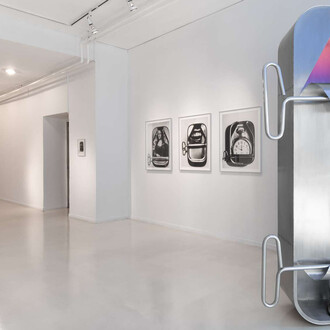Arteast 2000+ was the first museum collection conceived with a focus on Eastern European postwar avant-garde art in a broader international context. Since its inception in 2000, the collection has become well known for providing a comprehensive overview of art in the region. Similarly, it is recognized for the insight it provides into certain shared sociopolitical issues that are or were of central concern for artists in the formerly socialist countries. In 2011, the Arteast 2000+ collection came to form the core of the newly founded Museum of Contemporary Art Metelkova (+MSUM), which operates as part of Moderna galerija in Ljubljana.
The selection of works from Arteast 2000+ for the new, refreshed exhibition of the collection addresses the question: How to go on? This is all the more relevant as the collection was conceived in the 1990s, when events such as the dissolution of the Soviet Union and the end of the Eastern Bloc, and the breakup of and wars in Yugoslavia, reshaped the political, economic and cultural landscape of the East. The radical changes of that decade were so profound that their consequences continue to haunt us to this day. So what is left of the idea of Eastern Europe more than 30 years after the end of the Cold War? It has all but disappeared from the geopolitical map of the world, to be replaced by the Global East, Central Europe, the Baltics, Southeast Europe, or the Western Balkans. The overturning of one system (communism) in order to copy another (liberal democracy) left most of the region with decades of social inequality, corruption, and a general feeling of powerlessness. It is now accurate to say that there is no longer just one Eastern Europe, but many. As a consequence, the Arteast 2000+ collection is also changing, with an emphasis on an expanded notion and understanding of these multiple Easts, their arts, artists, art collectives, and the social and political contexts that have defined this geopolitical-social-cultural space over the last decade.
In this context, the part of the exhibition on the ground floor of the museum deals with the war in Yugoslavia, the transition to capitalism, the collapse of the Soviet Union, and the end of the idea of Eastern Europe as a socialist project. It addresses themes of social hierarchy and power relations, the state, identity, language, community, and direct reactions to reality, as well as critiques of the past and doubts about the future. This section presents a selection of works by the artists Jusuf Hadžifejzović, Igor Grubić, Vlado Martek, Darinka Pop - Mitić, Dan Perjovschi, Tone Stojko, Bálint Szombathy, Škart, Jane Štravs, Slaven Tolj, and Konstantin Zvezdochiotov.
The new installation of the collection on the first floor includes works by women artists that have been grouped around two broad themes: patriarchy, the body, and the media on the one hand, and ideology and war on the other. The artists representing the former are Marina Abramović, Vlasta Delimar, Alla Georgieva, Katalin Ladik, and Natalia LL, and those representing the latter are Maja Bajević, Jenny Holzer, Sanja Iveković, Zofia Kulik, Goranka Matić, and Milica Tomić. These artists do not necessarily depart from feminism as a defining or starting point of their actions, but from a position of rebellion against and noncompliance with any form of dominance and discrimination, be it male dominance over women in predominantly patriarchal societies or militarisms, sexisms, and nationalisms of all shapes and sizes, as well as the devastating impact capitalism has on society as a whole. Their performances and actions can be seen as acts of rebellion, disturbing the ingrained social arrangement of power, whereby the ideology of those in dominant positions is questioned and can therefore no longer be seen as valid or taken for granted.
An important part of the exhibition, which is related to the previous exhibition with a title Things break down, is OHO Group and their concept of reism. The members spoke of the hooligan role of art, which had to act destructively if it was to liberate man from the conceptual shackles of the cultural order of the time. In the spirit of reism, things are liberated from the yoke of functionalism and their alienation, and function on the level of subjects in the autonomy they have achieved. Dialogue between people and things happens when people ask things to name themselves. But this action can also be seen as a political statement in the sense that everyone is allowed to be who they are. It is a utopian liberation of things in the sense of reification. This installation includes the short film Revolution (1975), directed by the pioneer of Slovenian modernist cinema Boštjan Hladnik and based on the comic strip The light of darkness by the OHO Group members and authors Marko Pogačnik and Iztok Geister – Plamen.
After its collapse, the social system that the OHO Group resisted in this way left behind a number of monuments that had once foreshadowed the utopia of the society to come, and which had been used to preserve identity and determine the future. In fact, even monuments whose meaning has changed due to the ensuing social or political developments have taken on a life of their own, most often in contrast to their frequently monumental and invincible appearance. The artists in the exhibition reflect on their role and fate and possible alternatives in different ways. The installation includes the works of Yuri Avvakumov, Manca Bajec, György Galántai, Igor Grubić, Dejan Habicht, Sanja Iveković, Vladimir Kupriyanov, Siniša Labrović, David Maljković, Slavko Matković, New Collectivism, and the Nonument Group (Martin Bricelj Baraga, Nika Grabar, Miloš Kosec, Neja Tomšič). The installation The lives of monuments presents a documentary exhibition on monuments related to World War II from the time of socialist Yugoslavia.
















